unit 5英语报刊选读
- 格式:ppt
- 大小:132.50 KB
- 文档页数:18
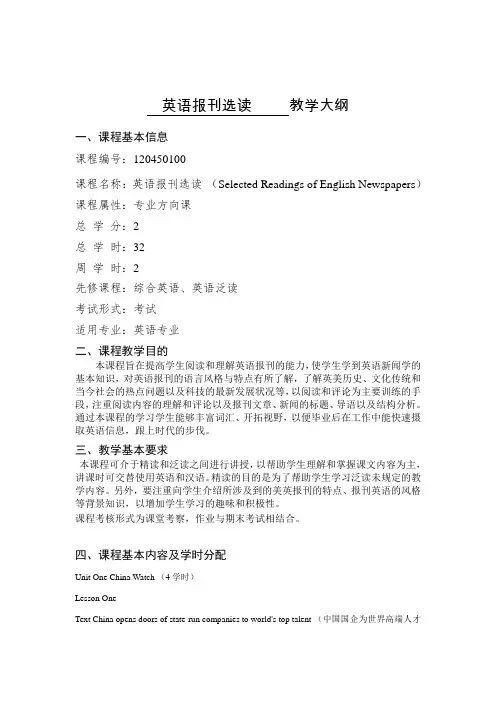
一、课程基本信息课程编号:120450100课程名称:英语报刊选读(Selected Readings of English Newspapers)课程属性:专业方向课总学分:2总学时:32周学时:2先修课程:综合英语、英语泛读考试形式:考试适用专业:英语专业二、课程教学目的本课程旨在提高学生阅读和理解英语报刊的能力,使学生学到英语新闻学的基本知识,对英语报刊的语言风格与特点有所了解,了解英美历史、文化传统和当今社会的热点问题以及科技的最新发展状况等,以阅读和评论为主要训练的手段,注重阅读内容的理解和评论以及报刊文章、新闻的标题、导语以及结构分析。
通过本课程的学习学生能够丰富词汇、开拓视野,以便毕业后在工作中能快速摄取英语信息,跟上时代的步伐。
三、教学基本要求本课程可介于精读和泛读之间进行讲授,以帮助学生理解和掌握课文内容为主,讲课时可交替使用英语和汉语。
精读的目的是为了帮助学生学习泛读未规定的教学内容。
另外,要注重向学生介绍所涉及到的美英报刊的特点、报刊英语的风格等背景知识,以增加学生学习的趣味和积极性。
课程考核形式为课堂考察,作业与期末考试相结合。
四、课程基本内容及学时分配Unit One China Watch (4学时)Lesson OneText China opens doors of state-run companies to world's top talent (中国国企为世界高端人才敞开大门)(The Washington Post, November 16, 2011)新闻写作何谓NewsLesson TwoText An American in Beijing(中国经济迅猛发展,留学生蜂拥而至)(Time, April 4,2008)语言解说 PresenceLesson ThreeText Tiger Mom ... Meet Panda Dad(熊猫爸爸挑战虎妈育儿经)(The Wall Street Journal, March 29,2011)新闻写作新闻体裁Unit Two United States (Ⅰ)(4学时)Lesson FourText Is an Ivy League Diploma Worth It?(上常春藤名校,值吗?)(The Wall Street Journal, November 8,2011)读报知识 Ivy League & Seven Sisters CollegesLesson FiveText Debt Burden Alters Outlook for US Graduates(求学负债:美国毕业生前景堪忧)(The Financial Times, June 1,2012)学习方法读懂标题(I)Lesson SixText The Evolution Wars(进化论与上帝造人说之争)(Time, August 15, 2005)读报知识宗教Unit Three United States (Ⅱ)(4学时)Lesson SevenText Obama Wins a Second Term as U.S. President(奥巴马连任总统:任重道远)(The Washington Post, November 7,2012)读报知识美国总统选举Lesson EightText The Economy Sucks. But Is It' 92 Redux?(经济不振,难道08年大选是92年的翻版吗?)(Newsweek, January 21, 2008)语言解说 Stupid和Technical(ly)Lesson NineText Five myths about the American dream(对美国梦的种种困感)(The Washington Post, Jan 6,2012)新闻写作导语(Lead)Lesson TenText Is America-s new declinism for real?(美国是真的衰落了吗?)(Financial Times, November 24, 2008)语言解说 EstablishmentUnit Four United States(Ⅲ)(4学时)Unit Five Britain (4学时)Unit Six The World (4学时)Unit Seven Society (4学时)Unit Eight Business and Science (2学时)Unit Nine Sports and Entertainment(2学时)五、教材及主要参考书目郭影平《最新报刊英语阅读》东南大学出版社 2010马建国《英文报刊导读》,外语教学与研究出版社,2002周学艺《英美报刊文章选读(精选本)》,北京大学出版社1997周学艺《英美报刊文章选读(精选本)学习辅导》,北京大学出版社1997端木义万,《英美报刊阅读教程》南京大学出版社,1997。
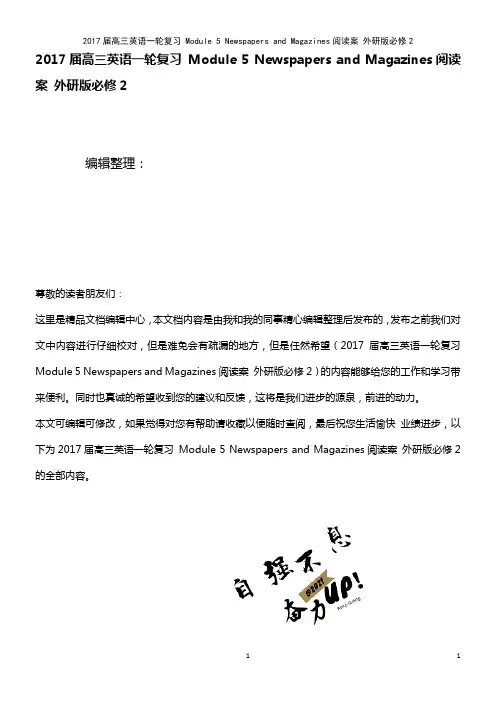
2017届高三英语一轮复习 Module 5 Newspapers and Magazines阅读案外研版必修22017届高三英语一轮复习Module 5 Newspapers and Magazines阅读案外研版必修2编辑整理:尊敬的读者朋友们:这里是精品文档编辑中心,本文档内容是由我和我的同事精心编辑整理后发布的,发布之前我们对文中内容进行仔细校对,但是难免会有疏漏的地方,但是任然希望(2017届高三英语一轮复习Module 5 Newspapers and Magazines阅读案外研版必修2)的内容能够给您的工作和学习带来便利。
同时也真诚的希望收到您的建议和反馈,这将是我们进步的源泉,前进的动力。
本文可编辑可修改,如果觉得对您有帮助请收藏以便随时查阅,最后祝您生活愉快业绩进步,以下为2017届高三英语一轮复习Module 5 Newspapers and Magazines阅读案外研版必修2的全部内容。
2017届高三英语一轮复习 Module 5 Newspapers and Magazines阅读案外研版必修2Module5 Newspapers and Magazines 综合运用巩固案I。
单词填空1。
He is so poor that he needs ____ (金融的) help to finish his schooling。
2.Please accept my ______ (祝贺) on your marriage.3。
The passengers all went ______ (登机)。
4。
Landing on the moon for the first time was a great ______ (成就)。
5.They opened the door and ______ (欢迎) us in。
6.Have you seen John’s __________ (照片)in the newspaper?7。

英语报刊选读答案英语报刊选读答案【篇一:英语报刊选读参考答案】>英语报刊选读journalistic reading教师用书teacher’s book总主编王嘉褆主编林玫刘雁bookone .................................................................................................... ............... 2 unit 1campus ............................................................................................. ........... 2 unit 2entertainment ................................................................................... ........... 5 unit 3entertainment ................................................................................... ........... 9 unit 4food ................................................................................................... ........ 12 unit 5crime ................................................................................................. ........ 15 unit 6disaster ............................................................................................. ......... 19 unit 7sports ................................................................................................ ......... 23 unit 8art ...................................................................................................... ........ 28 unit 9economy ........................................................................................... ......... 31 unit 10ecology ............................................................................................. ....... 36 unit 11health ...................................................................................................... 39 unit12 automobiledriving ............................................................................. 43 unit 13 qualityproblems (48)unit 14shopping ........................................................................................... ....... 52 unit 15 guncontrol ..............................................................................................56 unit 16psychology ....................................................................................... . (59)ibook oneunit 1 campus i.vocabulary builder 1. definition1) chaotic: extremely disorganized; badly organized; be inmess 2) primary: main; most important; key; major; chief; prime; principal 3) seduce: attract; tempt4) highlight: the most important, interesting, or enjoyable partof something such as a holiday, performance, or sports competition 5) reluctant: unwilling6) compelling: very interesting or exciting, so that you have to pay attention7) reveal: show; indicate8) mainstream: accepted by or involving most people in a society; normal; ordinary9) critical: important; crucial10) evolution: a long, gradual process during which something develops and changes, usually becoming more advanced; a gradual change and development 2. terms translation 1) a bipartisan consensus22) high school diploma 3) drop-out rate 4) college wagepremium 5) the k-12 system6) more academically rigorous 7) well-rounded citizens 8)certification tests9) career and technical education 3. blank filling 1) perseveredinsisted 6) agony assure/reassure11) insure/ensure 12) insure assured/reassured ii.translation1. 选择圣路易斯的华盛顿大学是个不错的决定,但真正让我享受到理想大学生活的,(不是大学本身)是我到了大学后作的一些决定。

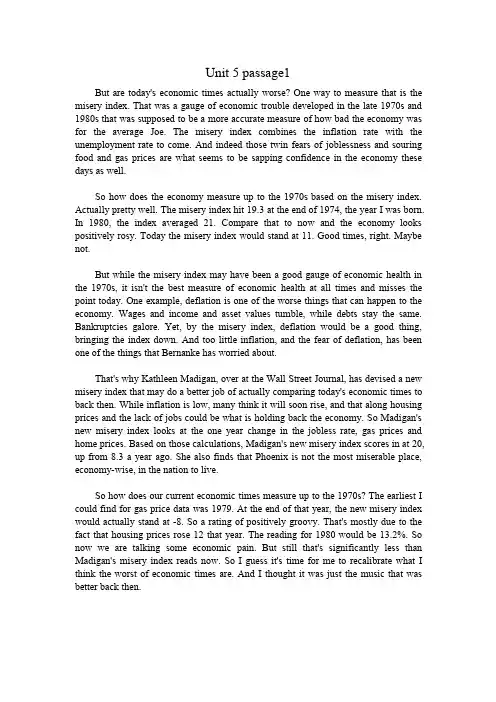
Unit5passage1But are today's economic times actually worse?One way to measure that is the misery index.That was a gauge of economic trouble developed in the late1970s and 1980s that was supposed to be a more accurate measure of how bad the economy was for the average Joe.The misery index combines the inflation rate with the unemployment rate to come.And indeed those twin fears of joblessness and souring food and gas prices are what seems to be sapping confidence in the economy these days as well.So how does the economy measure up to the1970s based on the misery index. Actually pretty well.The misery index hit19.3at the end of1974,the year I was born. In1980,the index pare that to now and the economy looks positively rosy.Today the misery index would stand at11.Good times,right.Maybe not.But while the misery index may have been a good gauge of economic health in the1970s,it isn't the best measure of economic health at all times and misses the point today.One example,deflation is one of the worse things that can happen to the economy.Wages and income and asset values tumble,while debts stay the same. Bankruptcies galore.Yet,by the misery index,deflation would be a good thing, bringing the index down.And too little inflation,and the fear of deflation,has been one of the things that Bernanke has worried about.That's why Kathleen Madigan,over at the Wall Street Journal,has devised a new misery index that may do a better job of actually comparing today's economic times to back then.While inflation is low,many think it will soon rise,and that along housing prices and the lack of jobs could be what is holding back the economy.So Madigan's new misery index looks at the one year change in the jobless rate,gas prices and home prices.Based on those calculations,Madigan's new misery index scores in at20, up from8.3a year ago.She also finds that Phoenix is not the most miserable place, economy-wise,in the nation to live.So how does our current economic times measure up to the1970s?The earliest I could find for gas price data was1979.At the end of that year,the new misery index would actually stand at-8.So a rating of positively groovy.That's mostly due to the fact that housing prices rose12that year.The reading for1980would be13.2%.So now we are talking some economic pain.But still that's significantly less than Madigan's misery index reads now.So I guess it's time for me to recalibrate what I think the worst of economic times are.And I thought it was just the music that was better back then.至少对20世纪70年代出生的我们这一代人,那十年仍然是最糟糕的时代。

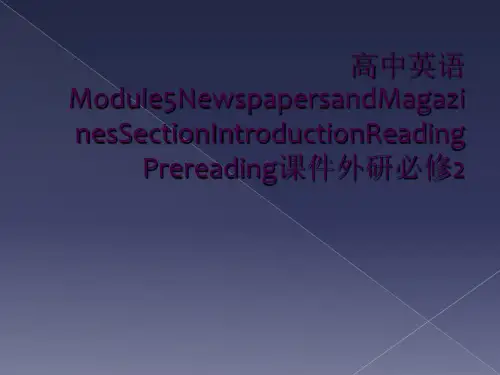
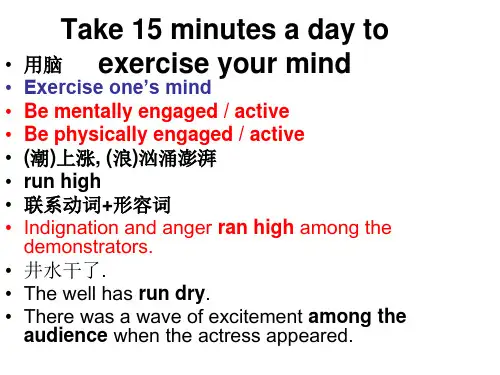
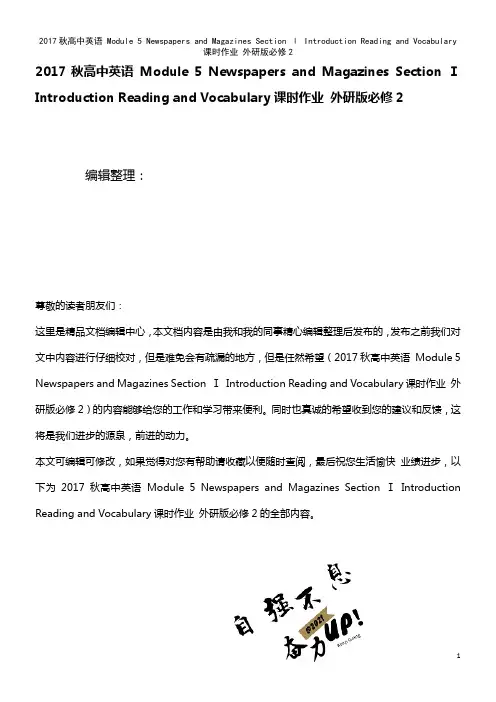
2017秋高中英语Module 5 Newspapers and Magazines Section ⅠIntroduction Reading and Vocabulary课时作业外研版必修2编辑整理:尊敬的读者朋友们:这里是精品文档编辑中心,本文档内容是由我和我的同事精心编辑整理后发布的,发布之前我们对文中内容进行仔细校对,但是难免会有疏漏的地方,但是任然希望(2017秋高中英语Module 5 Newspapers and Magazines Section ⅠIntroduction Reading and Vocabulary课时作业外研版必修2)的内容能够给您的工作和学习带来便利。
同时也真诚的希望收到您的建议和反馈,这将是我们进步的源泉,前进的动力。
本文可编辑可修改,如果觉得对您有帮助请收藏以便随时查阅,最后祝您生活愉快业绩进步,以下为2017秋高中英语Module 5 Newspapers and Magazines Section ⅠIntroduction Reading and Vocabulary课时作业外研版必修2的全部内容。
Module 5 Section ⅠIntroduction, Reading and VocabularyⅠ。
单词拼写1.The photographer (摄影师) was trying to take a picture of the celebrity couple.2.In some countries it is unwise to talk about politics (政治) in the hearing of strangers.3.The life boat was sent out to rescue the sailors (船员) from the sinking ship。
4.There are many artificial satellites orbiting (绕轨道飞行) around the earth。
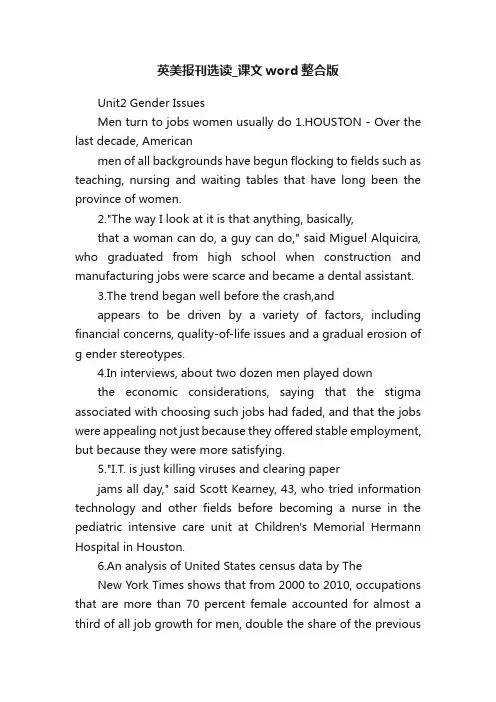
英美报刊选读_课文word整合版Unit2 Gender IssuesMen turn to jobs women usually do 1.HOUSTON - Over the last decade, Americanmen of all backgrounds have begun flocking to fields such as teaching, nursing and waiting tables that have long been the province of women.2."The way I look at it is that anything, basically,that a woman can do, a guy can do," said Miguel Alquicira, who graduated from high school when construction and manufacturing jobs were scarce and became a dental assistant.3.The trend began well before the crash,andappears to be driven by a variety of factors, including financial concerns, quality-of-life issues and a gradual erosion ofg ender stereotypes.4.In interviews, about two dozen men played downthe economic considerations, saying that the stigma associated with choosing such jobs had faded, and that the jobs were appealing not just because they offered stable employment, but because they were more satisfying.5."I.T. is just killing viruses and clearing paperjams all day," said Scott Kearney, 43, who tried information technology and other fields before becoming a nurse in the pediatric intensive care unit at Children's Memorial Hermann Hospital in Houston.6.An analysis of United States census data by TheNew York Times shows that from 2000 to 2010, occupations that are more than 70 percent female accounted for almost a third of all job growth for men, double the share of the previousdecade. 7.That does not mean that men are displacing women - those same jobs accounted for almost two-thirds of women's job growth. But in Texas, for example, the number of men who are registered nurses nearly doubled in that time period.8.The shift includes low-wage jobs as well.Nationally, two-thirds more men were bank tellers, almost twice as many were receptionists and two-thirds more were waiting tables in 2010 than a decade earlier.9.Even more striking is the type of men who aremaking the shift. From 1970 to 1990, according to a study by Mary Gatta, senior scholar at Wider Opportunities for Women, an organization based in Washington, D.C., and Patricia A. Roos, a sociologist at Rutgers University in New Jersey, men who took so-called pink-collar jobs tended to be foreign-born, non-English speakers with low education levels.10.Now, though, the trend has spread among men ofnearly all races and ages, more than a third of whom have a college degree. In fact, the shift is most pronounced among young, white, college-educated men like Charles Reed, a sixth-grade math teacher at Patrick Henry Middle School in Houston.11.Mr. Reed, 25, intended to go to law school after atwo-year stint with Teach for America, a national teacher corps of recent college graduates who spend two years helping under-resourced urban and rural public schools. But Mr. Reed fell in love with teaching. He says the recession had little to do with it, though he believes that, by limiting prospects for new law school graduates, it made his father, a lawyer, more accepting.12.To the extent that the shift to "women's work"has been accelerated by recession, the change may reversewhen the economy recovers. "Are boys today saying, 'I want to grow up and be a nurse?'" asked Heather Boushey, senior economist at the Center for American Progress."Or are they saying, 'I want a job that's stable and recession-proof?'"13.Daniel Wilden, a 26-year-old Army veteran andnursing student, said he had gained respect for nursing when he saw a female medic use a Leatherman tool to save the life of his comrade."She was a beast," he said admiringly.14.More than a few men said their new jobs werefar harder than they imagined. But these men can expect success. Men earn more than women even in female-dominated jobs. And white men in particular who enter those fields easily move up to supervisory positions, a phenomenon known as the glass escalator, said Adia Harvey Wingfield, a sociologist at Georgia State University.15."I hated my job every single day of my life," saidJohn Cook, 55, who got a modest inheritance that let him drop a $150,000-a-year database consultant's job to enter nursing school. 16.His starting salary will be two thirds lower, but database consulting does not typically earn hugs like the one Mr. Cook received from a girl after he took care of her premature baby sister. "It's like, people get paid for doing this kind of stuff?"Mr. Cook said, tears coming to his eyes as he recounted the episode.17.Several men cited the same reasons for seekingout pink-collar work that have drawn women to such careers: less stress and more time at home.At John G. Osborne Elementary School, Adrian Ortiz, 42,joked that he was one of the few Mexicans who made more in his native country, where he was a hard-working lawyer, than he did in the United States as a kindergarten teacher in a bilingual classroom. "Now," he said, "my priorities are family, 100 percent."18.Betsey Stevenson, a labor economist at theUniversity of Pennsylvania, said she was not surprised that changing gender roles at home, where studies show men are shouldering more of the domestic burden, are showing up in career choices. "We tend to study these patterns of what's going on in the family and what's going on in the workplace as separate, but they're very much intertwined," she said. "So as attitudes in the family change, attitudes toward the workplace have changed."19.In a classroom at Houston Community College,Dexter Rodriguez, 35, said his job in tech support had not been threatened by the tough economy. Nonetheless, he said, his family downsized the house, traded the new cars for used ones and began to live off savings, all so Mr.Rodriguez could train for a career he regarded as more exciting.20."I put myself into the recession," he said,"because I wanted to go to nursing school."Unit3 E-CommerceThe Post-Cash Economy1.In London, travelers can buy train tickets withtheir phones - and hold up the phones for the conductor to see. And in Starbucks coffee shops in the United States, customers can wave their phones in front of the cash register and pay for their soy chai lattes.2.Money is not what it used to be, thanks to theInternet. And the pocketbook may soon be destined for the dustbin of history - at least if some technology companies get their way.3.The cellphone increasingly contains theessentials of what we need to make transactions."Identification, payment and personal items," as Hal Varian, the chief economist at Google, pointed out in a new survey conducted by the Pew Research Center in Washington, D.C. "All this will easily fit in your mobile device and will inevitably do so."4.The phone holds and records plenty more vitalinformation: It keeps track of where you are, what you like and who your peers are. That data can all be leveraged to sell you things you never knew you needed.5.The survey, released last month by the PewResearch Center's Internet and American Life Project along with Elon University's Imagining the Internet Center in North Carolina, asked justover 1,000 technologists and social scientists to opine on the future of the wallet in 2020. Nearly two-thirds agreed that "cash and credit cards will have mostly disappeared" and been replaced with "smart" devices able to carry out a transaction.But a third of the survey respondents countered that consumers would fear for the security of transactions over a mobile device and worry about surrendering so much data about their purchasing habits.6.Sometimes, those with fewer options are theones to embrace change the fastest. In Kenya, a service called M-Pesa (pesa is money in Swahili) acts like a banking system for those who may not have a bank account. With a rudimentary cellphone, M-Pesa users can send and receivemoney through a network of money agents, including cellphone shops. And in India, several phone carriers allow their customers to pay utility bills and transfer small amounts of money over their cellphones.7.Several technology companies, big and small,are busy trying to make it easier for us to buy and sell all kinds of things without our wallets. A start-up,WePay, describes itself as a service that allows the smallest merchant - say, a dog walker - to get paid; the company verifies the reputations of payers and sellers by analyzing, among other things, their Facebook accounts. 8. A British start-up, called Blockchain, offers afree iPhone application allowing customers to use a crypto-currency called bitcoins, which users can mint on their computers.9. A company called Square began by offering asmall accessory to enable food cart vendors and other small merchants to accept credit cards on phones and iPads. Square's latest invention allows customers to register an account with Square merchants and pay simply by saying their names. The customer's picture pops up on the merchant's iPad.10.Google Wallet has been designed to sit in yourphone, be linked to your credit card, and let you pay by tapping your phone on a reader, using what is known as near field technology.But Google Wallet works on only four kinds of phones, and not many merchants are equipped for near field technology.11.Meanwhile, PayPal, which allows people tomake payments over the Internet, has quietly begun to persuade its users to turn to their cellphones. PayPal posted about $118 billion in total transactions last year and became thefastest-growing segment of eBay, its parent company.12."The physical wallet, which had no innovationin the last 50 years, will become an artifact,"John J. Donahoe, the chief executive of eBay, told me recently. The wallet would move into the cloud, and ideally, from his perspective, into PayPal. No more would the consumer worry about losing a wallet. Everything, he declared, would be contained within PayPal. It would also enable the company to collect vast amounts of data about customer habits, purchases and budgets.13.Mr. Donahoe said he wanted his company to become "a mall in your pocket."14.I recently described PayPal's plans to AlessandroAcquisti, an economist who studies digital privacy at Carnegie Mellon University in Pittsburgh. Mr. Acquisti smiled. If today all you need to do is enter your phone number and PIN when you visit a store, perhaps tomorrow, he said, that store will be able to detect your phone by its unique identifier. Perhaps, you won't have to shop at all. Your shopping data would be instead collected, analyzed and used to tell you exactly what you need: a motorcycle from Ducati or purple rain boots in the next size for your growing child. Money will be seamlessly taken from your account. A delivery will arrive at your doorstep. "In the future, maybe you won't have to pay," Mr. Acquisti offered, only half in jest."The transaction will be made for you."Unit4Cultural ExchangeAsia’s Endangered Species: the Expat1.Forget expats. Western companies doingbusiness in Asia are now looking to locals to fill the most important jobs in the region.2.Behind the switch, experts say, are severalfactors, including a leveled playing field in which Western companies must approach newly empowered Asian companies and consumers as equals and clients—not just manufacturing partners./doc/2216449449.html,panies now want executives who can securedeals with local businesses and governments without the aid of a translator, and who understand that sitting through a three-hour dinner banquet is often a key part of the negotiating process in Asia, experts say.4.In fact, three out of four senior executives hiredin Asia by multinationals were Asian natives already living in the region, according to a Spencer Stuart analysis of 1,500 placements made from 2005 to 2010. Just 6% were noncitizens from outside of Asia.5."It's a strategic necessity to be integrated in theculture. Otherwise, the time to learn all of it takes forever," said Arie Y. Lewin, a professor of strategy and international business at Duke University's Fuqua School of Business. He adds that locals may better navigate a business culture where copycats and competitors often play bydifferent rules.6.What's more, a failed expatriate hire can be acostly mistake and slow a firm's progress in the region, said Phil Johnston, a managing director at recruiter Spencer Stuart.7.To help companies fill Asia-based executiveroles, at least two search firms—Spencer Stuart and Korn/Ferry International—say they have begun classifying executives in four broad categories: Asia natives steeped in localculture but educated in the U.S. or Europe; the foreigner who has lived or worked in Asia for a long time;a person of Asian descent who was born orraised in a Western country but has had little exposure to Asia; and the local Asian executive who has no Western experience.8.For companies seeking local expertise, bothfirms said the first category is by far the mostsought-after. But Mr. Johnston said those candidates are difficult to find and retain, and they can command salaries of $750,000 to $1 million—on par with, and sometimes more than, their expat counterparts.9.German conglomerate Siemens AG in 2010hired Mei-Wei Cheng, a China-born Cornell University graduate, to head its Chinese operations—a role previously held by European executives.10.While Siemens's European executives had madeinroads with Chinese consumers—building sales in the region to nearly one-tenth of global revenue—the firm realized it needed someone who could quickly tap local business partners.11.After an extensive search, Siemens hired Mr.Cheng, formerly CEO at the Chinese subsidiaries of Ford Motor Co. and General Electric Co. GE12.The decision to hire locally seems to have paidoff for Siemens: In his first 18 months on the job, Mr. Cheng forged two wind-power jointventures with Shanghai Electric Group Co.13.Mr. Cheng communicates easily with localofficials, a major advantage when it comes to selling energy technology to individual cities, says Brigitte Ederer, head ofhuman resources for Siemens and a member of the company's managing board. Many local officials don't speak English.14.Bob Damon, president of recruiter Korn/FerryInternational's North American operations, said the current talent pool for executive roles is so limited that most top Asian executives simply rotate from one Western company to another, as Mr. Cheng did.15.Other companies are adding to the demand bycreating new positions in Asia.Campbell Soup Co. CPB last week announced the appointmentof Daniel Saw as its first-ever president of Asia operations, while Canadian conglomerate Bombardier Inc. BBD.B.T hired Albert Li to filla new role overseeing its aerospace business inChina. Both executives were born in Asia and have worked as regional managers for Western multinationals.16.Meanwhile, younger Chinese professionals arepositioning themselves to meet the need for executive talent in the years to come. Nearly four in 10 American M.B.A. programs say China was their fastest-growing source of foreign applicants last year, according to the Graduate Management Admission Council, which administers the Graduate Management Admission Test.17.Foreigners with no Asia experience, on the otherhand, need not apply, recruiters said. Spencer Stuart's Mr. Johnston said he occasionally receives inquiries from Western middle managers, proclaiming that they are finally ready to make a career move to the region. He advises them that "there is nothing about their experience that is interesting or relevant to Asia."18.In hubs like Singapore and Hong Kong, expatsreceive as much as $200,000 a year in subsidies for housing, transportation and private schooling, Mr. Johnston said. Payments to offset taxes for these benefits add up to another $100,000.Altogether, a bad match can cost a company as much as $1 million, after figuring in relocation costs, he said.19.Monster Worldwide Inc. Chief Executive SalIannuzzi said the company has been hiring locally for several years, in part because he found deploying expatriates cost too much. "Ittakes them six months to figure out how to take a ferry, they're there for 12 months, and then they spend the next six months figuring out how to get home," he said.20.Like some other companies, Monster now tracksits own workers to ensure a pipeline of talent. 21.The online job-search company's current head ofChina operations, Edward Lo, a former fraternity brother of Mr. Iannuzzi, understands the local scene, is well connected in China and knows how to recruit, Mr. Iannuzzi said.Among Mr. Lo's duties: finding his own successor before he retires.22.Starwood Hotels & Resorts Worldwide Inc.based in White Plains, N.Y., also develops its own leaders for Asia, plucking people who have come up through the company ranks. For example, the head of Asia Pacific started in the 1970s on the finance team in Hong Kong, and the head of the Middle East region was a hotel manager who worked his way up.23.Having grown up in their markets, managersunderstand customer needs, said Starwood CEO Frits van Paasschen. Regional heads in China, for instance, know that whendealing with land owners or developers, deals are less "transactional," and more "trust-based," he said.They also know that Chinese travelers—who now comprise the majority of hotel guests in the region—feel more at home when they're supplied with tea kettles, slippers and chopsticks, headded.24.For fast-food company Yum Brands Inc. CEODavid Novak calls his Asia-bred regional head and executive team "our single biggest competitive advantage." China has become the company's biggest earnings driver, comprising more than 40% of operating profit.25.Thanks to Yum's China leaders, Mr. Novak says,KFC in China began serving rice porridge and soy milk for breakfast, and Pizza Hut now offers an afternoon tea menu—both of which have been big hits among local customers.Unit5Auto-WorldThe Future of the Car :Clean, Safe and it Drives itselfCars have already changed the way we live. They are likely to do so again1.SOME inventions, like some species, seem tomake periodic leaps in progress. The car is one of them. Twenty-five years elapsed between Karl Benz beginning small-scale production of his original Motorwagen and the breakthrough, by Henry Ford and his engineers in 1913, that turned the car into the ubiquitous, mass-market item that has defined the modern urban landscape. By putting production of the Model T on moving assembly lines set into the floor of his factory in Detroit, Ford drastically cut the time needed to build it, and hence its cost. Thus begana revolution in personal mobility. Almost abillion cars now roll along the world’s highways.2.Today the car seems poised for another burst ofevolution. One way in which it is changing relates to its emissions. As emerging markets grow richer, legions of new consumers are clamouring for their first set of wheels. For the whole world to catch up with American levels of car ownership, the global fleet would have to quadruple. Even a fraction of that growth would present fearsome challenges, from congestion and the price of fuel to pollution and global warming.3.Yet, as our special report this week argues,stricter regulations and smarter technology are making cars cleaner, more fuel-efficient and safer than ever before. China, its cities choked in smog, is following Europe in imposing curbs on emissions of noxious nitrogen oxides and fine soot particles. Regulators in most big car marketsare demanding deep cuts in the carbon dioxide emitted from car exhausts. And carmakers are being remarkably inventive in finding ways to comply.4.Granted, battery-powered cars have disappointed.They remain expensive, lack range and are sometimes dirtier than they look—for example, if they run on electricity from coal-fired power stations. But car companies are investing heavily in other clean technologies. Future motorists will have a widening choice of super-efficient petrol and diesel cars, hybrids (which switch between batteries and an internal-combustion engine) and models that run on natural gas or hydrogen. As for the purely electric car, its time will doubtless come.Towards the driverless, near-crashless car 5.Meanwhile, a variety of ―driver assistance‖technologies are appearing on new cars, which will not only take a lot of the stress out of driving in traffic but also prevent many accidents. More and more new cars can reverse-park, read traffic signs, maintain a safe distance in steady traffic and brake automatically to avoid crashes. Some carmakers are promising technology that detects pedestrians and cyclists, again overruling the driver and stopping the vehicle before it hits them.A number of firms, including Google, are busy trying to take driver assistance to its logical conclusion by creating cars that drive themselves to a chosen destination without a human at the controls. This is where it gets exciting.6.Sergey Brin, a co-founder of Google, predictsthat driverless cars will be ready for sale tocustomers within five years. That may be optimistic, but the prototypes that Google already uses to ferry its staff (and a recent visitor from The Economist) along Californian freeways are impressive. Google is seeking to offer the world a driverless car built from scratch, but it is more likely to evolve, and be accepted by drivers, in stages.7.As sensors and assisted-driving softwaredemonstrate their ability to cut accidents, regulators will move to make them compulsory for all new cars. Insurers are already pressing motorists to accept black boxes that measure how carefully they drive: these will provide a mass of data which is likely to show that putting the car on autopilot is often safer than driving it.Computers never drive drunk or while texting. 8.If and when cars go completely driverless—forthose who want this—the benefits will be enormous. Google gave a taste by putting a blind man in a prototype and filminghim being driven off to buy takeaway tacos. Huge numbers of elderly and disabled people could regain their personal mobility. The young will not have to pay crippling motor insurance, because their reckless hands and feet will no longer touch the wheel or the accelerator. The colossal toll of deaths and injuries from road accidents—1.2m killed a year worldwide, and 2m hospital visits a year in America alone—should tumble down, along with the costs to health systems and insurers.9.Driverless cars should also ease congestion andsave fuel. Computers brake faster than humans.And they can sense when cars ahead of them are braking. So driverless cars will be able to drive much closer to each other than humans safely can. On motorways they could formfuel-efficient ―road trains‖, gliding along in the slipstream of the vehicle in front. People who commute by car will gain hours each day to work, rest or read a newspaper.Roadblocks ahead10.Some carmakers think this vision of the future is(as Henry Ford once said of history) bunk.People will be too terrified to hurtle down the motorway in a vehicle they do not control: computers crash, don’t t hey? Carmakers whose self-driving technology is implicated in accidents might face ruinously expensive lawsuits, and be put off continuing to develop it.11.Yet many people already travel, unwittingly, onplanes and trains that no longer need human drivers. As with those technologies, the shift towards driverless cars is taking place gradually.The cars’ software will learn the tricks that humans use to avoid hazards: for example, braking when a ball bounces into theroad, because a child may be chasing it. G oogle’s self-driving cars have already clocked up over 700,000km, more than many humans ever drive;and everything they learn will become available to every other car using the software. As for the liability issue, the law should be changed to make sure that when cases arise, the courts take into account the overall safety benefits of self-driving technology.12.If the notion that the driverless car is round thecorner sounds far-fetched, remember that TV and heavier-than-air flying machines once did, too.One day people may wonder why earlier generations ever entrusted machines as dangerous as cars to operators as fallible as humans.Unit6 RomanceThe Modern Matchmakers现代红娘Internet dating sites claim to have brought scienceto the age-old question of how to pair offsuccessfully. But have they?互联网相亲网站声称已经将科技运用如何成功配对的问题之上。

Lesson4 Is an Ivy League Diploma Worth It?花钱读常春藤名校值不值?1.如果愿意的话,施瓦茨(Daniel Schwartz)本来是可以去一所常春藤联盟(Ivy League)院校读书的。
他只是认为不值。
2.18 岁的施瓦茨被康奈尔大学(Cornell University)录取了,但他最终却去了纽约市立大学麦考利荣誉学院(City University of New York’s Macaulay Honors College),后者是免费的。
3.施瓦茨说,加上奖学金和贷款的支持,家里原本是可以付得起康奈尔的学费的。
但他想当医生,他觉得医学院是更有价值的一项投资。
私立学校医学院一年的花费动辄就要4 万5 美元。
他说,不值得为了一个本科文凭一年花5 万多美元。
4.助学贷款违约率日益攀升,大量的大学毕业生找不到工作,因此越来越多的学生认定,从一所学费不太贵的学校拿到的学位和从一所精英学校拿到的文凭没什么区别,并且不必背负贷款负担。
5.Robert Pizzo 越来越多的学生选择收费较低的公立大学,或选择住在家里走读以节省住房开支。
美国学生贷款行销协会(Sallie Mae)的一份报告显示,2010 年至2011 学年,家庭年收入10 万美元以上的学生中有近25%选择就读两年制的公立学校,高于上一学年12%的比例。
6.这份报告称,这样的选择意味着,在2010 至2011 学年,各个收入阶层的家庭在大学教育上的花费比上一年少9%,平均支出为21,889 美元,包括现金、贷款、奖学金等。
高收入家庭的大学教育支出降低了18%,平均为25,760 美元。
这份一年一度的报告是在对约1,600 名学生和家长进行问卷调查后完成的。
7.这种做法是有风险的。
顶级大学往往能吸引到那些已经不再去其他学校招聘的公司前来招聘。
在许多招聘者以及研究生院看来,精英学校的文凭还是更有吸引力的。
2016-2017学年高中英语Module 5 Newspapers and Magazines Section ⅠIntroduction,Reading and Vocabulary课时作业外研版必修2编辑整理:尊敬的读者朋友们:这里是精品文档编辑中心,本文档内容是由我和我的同事精心编辑整理后发布的,发布之前我们对文中内容进行仔细校对,但是难免会有疏漏的地方,但是任然希望(2016-2017学年高中英语Module 5 Newspapers and Magazines Section ⅠIntroduction,Reading and Vocabulary 课时作业外研版必修2)的内容能够给您的工作和学习带来便利。
同时也真诚的希望收到您的建议和反馈,这将是我们进步的源泉,前进的动力。
本文可编辑可修改,如果觉得对您有帮助请收藏以便随时查阅,最后祝您生活愉快业绩进步,以下为2016-2017学年高中英语Module 5 Newspapers and Magazines Section ⅠIntroduction,Reading and Vocabulary课时作业外研版必修2的全部内容。
Section ⅠIntroduction,Reading and Vocabulary 姓名:________ 测试时间:45分钟本卷总分:50分自评或老师评分:________基础训练Ⅰ.根据首字母或括号内提示,写出单词的正确形式1。
A n________ is the member of an aircrew who is responsible for the aircraft’s course.2. The spacecraft is o________ the moon and it will land on it in a few hours。
3.A Chinese a________is sometimes called cosmonaut.4.The train’s about to leave。